An amalgamation of Green Distributed Generation (GDG) with Distribution Networks (DNs) was developed because its performance became more efficient and sustainable. It increased the challenges in the design and operation of the protection scheme and changed the short circuit current (SCC), voltage profile, power losses, and power flow direction after the GDG penetration. These changes rely on the number, size, location, and environmental influence according to the GDG type. Therefore, many researchers have discussed protection system challenges and presented types of protection approaches to find a robust protection layout for DNs integrated with GDGs to prevent the electrical equipment from being destroyed during abnormal conditions.
- protection scheme
- Green Distributed Generation (GDG)
- Protection Devices (PDs)
- Distribution Networks (DNs)
1. Protection Scheme Challenges with GDG Existence
1.1. Changes in Fault Currents and Short Circuit Level
1.2. Bidirectional Power Flow
1.3. Unsynchronized Reclosing
1.4. Undesirable Network Islanding
1.5. Blinding and Maloperation of Undesired Tripping of PDs in the Protection System
1.6. Loss of Main (LOM)
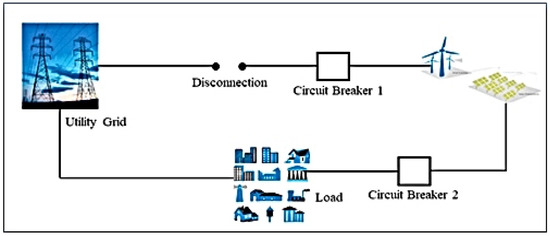
1.7. Topological Changes in the Power System
1.8. Intermittent Nature According to the Environmental Effect on GDGs
2. Protection Methodology with Detection Methods
2.1. Multi-Agent System (MAS)
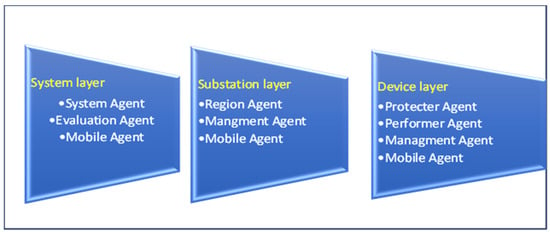
2.2. Fault Current Limiter (FCL)
2.3. Overcurrent Relay and Earth Fault
2.4. Recloser
2.5. Fuse
2.6. Coordination of PDs
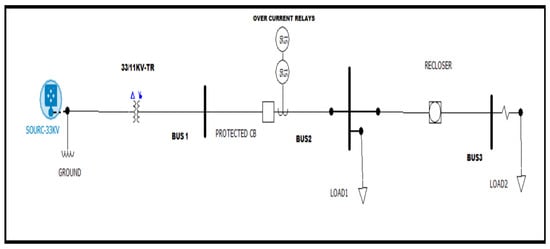
2.6.1. Over-Current Relay-Recloser-Fuse Coordination (without GDG)

where
𝑡_𝑜𝑝
M
L
Ip
𝐼𝐿 sensitivity by the relay as in (2) below:


where 𝑡𝑓 is the operating time of the fuse, 𝐼_𝑓𝑓 is the fault current passing through the fuse, and 𝑎 and b represent fuse constants. The operating time of the fuse is high depending on the b constant value.
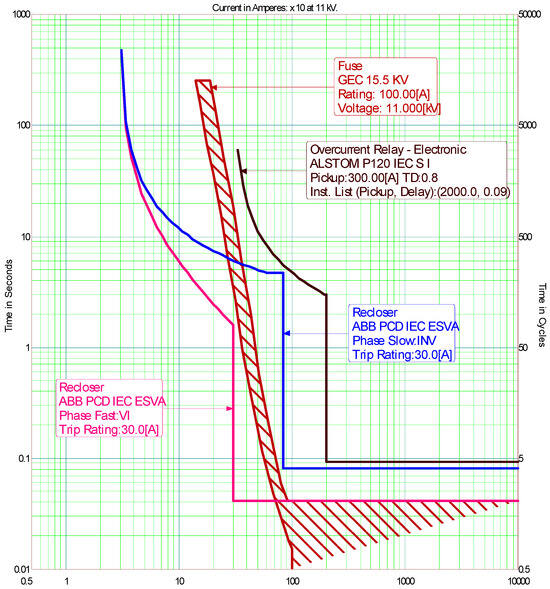
2.6.2. Over-Current Relay-Recloser-Fuse Coordination (with a GDG)


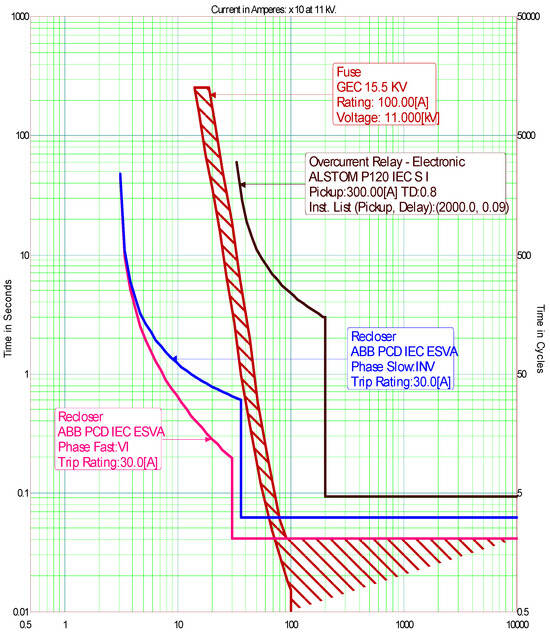
References
- Ahmed, A.J.; Alkhafaji, M.H.; Mahdi, A.J. Performance Enhancement of a Low-Voltage Microgrid by Measuring the Optimal Size and Location of Distributed Generation. Acta IMEKO 2022, 11, 1–8.
- Barra, P.H.A.; Coury, D.V.; Fernandes, R.A.S. A Survey on Adaptive Protection of Microgrids and Distribution Systems with Distributed Generators. Renew. Sustain. Energy Rev. 2020, 118, 109524.
- Sorrentino, E.; Rodríguez, J.V. Effects of Fault Type and Pre-Fault Load Flow on Optimal Coordination of Directional Overcurrent Protections. Electr. Power Syst. Res. 2022, 213, 108685.
- Fani, B.; Bisheh, H.; Karami-horestani, A. An Offline Penetration-Free Protection Scheme for PV-Dominated Distribution Systems. Electr. Power Syst. Res. 2018, 157, 1–9.
- Dagar, A.; Gupta, P.; Niranjan, V. Microgrid Protection: A Comprehensive Review. Renew. Sustain. Energy Rev. 2021, 149, 111401.
- Sampaio, F.C.; Leão, R.P.S.; Sampaio, R.F.; Melo, L.S.; Barroso, G.C. A Multi-Agent-Based Integrated Self-Healing and Adaptive Protection System for Power Distribution Systems with Distributed Generation. Electr. Power Syst. Res. 2020, 188, 106525.
- Beheshtaein, S.; Cuzner, R.; Savaghebi, M.; Guerrero, J.M. Review on Microgrids Protection. IET Gener. Transm. Distrib. 2019, 13, 743–759.
- Abdel-Galil, T.K.; Ahmed, E.B.; Abu-Elanien, E.; El-Saadany, E.F.; Girgis, A.; Mohamed, Y.A.-R.I.; Salama, M.M.A.; Zeineldin, H.H.M. Protection Coordination Planning with Distributed Generation; Canmet Energy Technology Centre: Ottawa, QC, Canada, 2007.
- Rebollal, D.; Carpintero-rentería, M.; Santos-martín, D.; Chinchilla, M. Microgrid and Distributed Energy Resources Standards and Guidelines Review: Grid Connection and Operation Technical Requirements. Energies 2021, 14, 523.
- Lazarou, S.; Vita, V.; Ekonomou, L. Protection Schemes of Meshed Distribution Networks for Smart Grids and Electric Vehicles. Energies 2018, 11, 3106.
- Larik, N.A.; Li, M.S.; Jamali, J.A.; Wu, Q.H.; Ahmed, T. Islanding Issues, Consequences, and a Robust Detection Method for Hybrid Distributed Generation Based Power Systems. Eng. Technol. Appl. Sci. Res. 2023, 13, 11484–11489.
- Antonova, G.; Nardi, M.; Power, D.E.; Pesin, M. Distributed Generation and Its Impact on Power Grids and Microgrids Protection. In Proceedings of the 2012 65th Annual Conference for Protective Relay Engineers, College Station, TX, USA, 2–5 April 2012.
- Razavi, S.; Rahimi, E.; Sadegh, M.; Esmaeel, A. Impact of Distributed Generation on Protection and Voltage Regulation of Distribution Systems: A Review. Renew. Sustain. Energy Rev. 2019, 105, 157–167.
- Brearley, B.J.; Prabu, R.R. A Review on Issues and Approaches for Microgrid Protection. Renew. Sustain. Energy Rev. 2017, 67, 988–997.
- Chandra, A.; Singh, G.K.; Pant, V. Protection of AC Microgrid Integrated with Renewable Energy Sources—A Research Review and Future Trends. Electr. Power Syst. Res. 2021, 193, 107036.
- Mohammadi, P. Protection Challenges of Distributed Energy Resources Integration in Power Systems. Ph.D. Thesis, Louisiana State University, Baton Rouge, LA, USA, 2017.
- Ekanayake, J.; Strbac, G.; Jenkins, N. Distributed Generation; The Institution of Engineering and Technology: London, UK, 2010; ISBN 9780863419584.
- Chowdhury, S.; Chowdhury, S.P.; Crossley, P. Microgrids and Active Distribution Networks; The Institution of Engineering and Technology: London, UK, 2009; ISBN 9781849191029.
- Cheng, Y.; Liu, Y.; Zhang, Z.; Li, Y. An Asymmetric Encryption-Based Key Distribution Method for Wireless Sensor Networks. Sensors 2023, 23, 6460.
- Abbaspour, E.; Fani, B.; Heydarian-Forushani, E. A Bi-Level Multi Agent Based Protection Scheme for Distribution Networks with Distributed Generation. Int. J. Electr. Power Energy Syst. 2019, 112, 209–220.
- Tejeswini, M.V.; Jacob Raglend, I.; Yuvaraja, T.; Radha, B.N. An Advanced Protection Coordination Technique for Solar In-Feed Distribution Systems. Ain Shams Eng. J. 2019, 10, 379–388.
- Yousaf, M.; Muttaqi, K.M.; Sutanto, D. Assessment of Protective Device Sensitivity with Increasing Penetration of Distributed Energy Resources. In Proceedings of the Australasian Universities Power Engineering Conference, AUPEC 2018, Auckland, New Zealand, 27–30 November 2018; pp. 1–6.
- Stennikov, V.; Barakhtenko, E.; Mayorov, G.; Sokolov, D.; Zhou, B. Coordinated Management of Centralized and Distributed Generation in an Integrated Energy System Using a Multi-Agent Approach. Appl. Energy 2022, 309, 118487.
- Fayazi, H.; Fani, B.; Moazzami, M.; Shahgholian, G. An Offline Three-Level Protection Coordination Scheme for Distribution Systems Considering Transient Stability of Synchronous Distributed Generation. Int. J. Electr. Power Energy Syst. 2021, 131, 107069.
- Abbaspour, E.; Fani, B.; Sadeghkhani, I.; Alhelou, H.H. Multi-Agent System-Based Hierarchical Protection Scheme for Distribution Networks With High Penetration of Electronically-Coupled DGs. IEEE Access 2021, 9, 102998–103018.
- Hojjaty, M.; Fani, B.; Sadeghkhani, I. Intelligent Protection Coordination Restoration Strategy for Active Distribution Networks. IET Gener. Transm. Distrib. 2021, 16, 397–413.
- Ghanbari, M.; Gandomkar, M.; Nikoukar, J. Protection Coordination of Bidirectional Overcurrent Relays Using Developed Particle Swarm Optimi- Zation Approach Considering Distribution Generation Penetration and Fault Current Limiter Placement Coordination de La Protection Des Relais de Surintensité. IEEE Can. J. Electr. Comput. Eng. 2021, 44, 143–155.
- Hassan, A.S.; Sun, Y.; Wang, Z. Optimization Techniques Applied for Optimal Planning and Integration of Renewable Energy Sources Based on Distributed Generation: Recent Trends. Cogent Eng. 2020, 7, 1766394.
- Sahebi, A.; Askarian-Abyaneh, H.; Sadeghi, S.H.H.; Samet, H.; Malik, O.P. Efficient Practical Method for Differential Protection of Power Transformer in the Presence of the Fault Current Limiters. IET Gener. Transm. Distrib. 2023, 17, 3861–3871.
- Rizwan, M.; Hong, L.; Waseem, M.; Shu, W. Sustainable Protection Coordination in Presence of Distributed Generation with Distributed Network. Int. Trans. Electr. Energy Syst. 2020, 30, 1–23.
- Hatata, A.; Kaddah, S.; Abdraboh, H.; Frahat, M. Optimal Directional Overcurrent Relay Coordination Using Artificial Immune Algorithm. Bull. Fac. Eng. Mansoura Univ. 2014, 39, 9–18.
- Esobinenwu, C.S. Performance Evaluation of Overcurrent Relay in a Distribution Substation For Improved Protection and Coordination. SADI Int. J. Sci. Eng. Technol. 2023, 10, 12–24.
- Kennedy, J.; Ciufo, P.; Agalgaonkar, A. A Review of Protection Systems for Distribution Networks Embedded with Renewable Generation. Renew. Sustain. Energy Rev. 2016, 58, 1308–1317.
- Xu, L.; Li, K.; Yang, Z.; Jiang, X. Analysis of Discharge Failure Mechanism of IGBT Power Modules. Energies 2023, 16, 6001.
- Schneider Electric. Protection Relays Guide 2012; Schneider Electric: Rueil-Malmaison, France, 2012.
- Department of the Army. Coordinated Power Systems Protection 1991; Department of the Army: Arlington County, VA, USA, 1991.
- Ninad, N.; Natural, C.; Canada, R.; Turcotte, D.; Canada, N.R. DER Penetration Level Impact on the Protection of Distribution Systems. In Proceedings of the 2023 CIGRE Canada Conference & Exhibition, Vancouver, BC, Canada, 25–28 September 2023.
- Manditereza, P.T.; Bansal, R. Renewable Distributed Generation: The Hidden Challenges—A Review from the Protection Perspective. Renew. Sustain. Energy Rev. 2016, 58, 1457–1465.
- Fern, A. Impact of Distributed Generation on Distribution System. Master’s Thesis, Aalborg University, Arlington, TX, USA, 2011.
- Han, Z. Protection Coordination in Networks with Renewable Energy Sources. Master’s Thesis, University of Manchester, Manchester, UK, 2014.
- Gers, J.M.; Holmes, E.J. Protection of Electricity Distribution Networks; Institution of Electrical Engineers: London, UK, 2005.
- Gómez, J.C.; Vaschetti, J.; Piumetto, M.; Arcurio, J.; Coyos, C. Protection of Power Semiconductors in Inverters, Using Fuses and Their Coordination with the Protection Schemes of the Distribution System. In Proceedings of the 19th International Conference on Renewable Energies and Power Quality (ICREPQ’21), Almeria, Spain, 28–30 July 2021.
- Al Talaq, M.; Al-Muhaini, M. Chapter 5—Optimal Coordination of Time Delay Overcurrent Relays for Power Systems with Integrated Renewable Energy Sources. In Power System Protection in Future Smart Grids; Uwstun, T.S., Ed.; Academic Press: Cambridge, MA, USA, 2023; pp. 81–107. ISBN 978-0-323-91780-3.
- Al Talaq, M.; Al-Muhaini, M. Optimal Coordination of Time Delay Overcurrent Relays for Power Systems with Integrated Renewable Energy Sources. Energies 2022, 15, 6749.
- Industrial and Commercial Power Systems Standards Development Committee. IEEE Recommended Practice for Protection and Coordination of Industrial and Commercial Power Systems; IEEE: New York City, NY, USA, 2001; ISBN 0-7381-2844-9.
- Yang, H.; Wen, F.; Ledwich, G. Optimal Coordination of Overcurrent Relays in Distribution Systems with Distributed Generators Based on Differential Evolution Algorithm. Eur. Trans. Electr. Power 2011, 23, 1–12.
- Hatata, A.Y.; Ebeid, A.S.; El-Saadawi, M.M. Application of Resistive Super Conductor Fault Current Limiter for Protection of Grid-Connected DGs. Alexandria Eng. J. 2018, 57, 4229–4241.
- Farkhani, J.S.; Zareein, M.; Soroushmehr, H.; Sieee, H.M. Coordination of Directional Overcurrent Protection Relay for Distribution Network With Embedded DG. In Proceedings of the 2019 5th Conference on Knowledge Based Engineering and Innovation (KBEI), Tehran, Iran, 28 February –1 March 2019; pp. 281–286.
- Elbaset, A.A.; Mohamed, A.F.A.; El-Zahab, E.A.; Hassan, M.A.M. Recloser-Fuse Settings in Distribution Systems with Optimizing Multiple Distributed Generation Considering Technical Aspects. Indones. J. Electr. Eng. Comput. Sci. 2019, 17, 1135–1149.
- Saad, S.M.; El Naily, N.; Wafi, J.; Hussein, T.; Mohamed, F.A. An Optimized Proactive Over-Current Protection Scheme for Modern Distribution Grids Integrated with Distributed Generation Units. In Proceedings of the 2018 9th International Renewable Energy Congress (IREC), Hammamet, Tunisia, 20–22 March 2018; pp. 1–6.
- Coster, E.J. Distribution Grid Operation Including Distributed Generation. Ph.D. Thesis, Eindhoven University of Technology, Eindhoven, The Netherlands, 2010.
- Abdelaziz, A.Y.; Talaat, H.E.A.; Nosseir, A.I.; Hajjar, A.A. An Adaptive Protection Scheme for Optimal Coordination of Overcurrent Relays. Electr. Power Syst. Res. 2002, 61, 1–9.
- Nikolaidis, V.C.; Desiniotis, D.; Papaspiliotopoulos, V.A.; Tsimtsios, A.M.; Korres, G.N. Optimal Recloser-Fuse and Distribution Network Protection Coordination Including Distributed Generation Relays. In Proceedings of the 2022 International Conference on Smart Energy Systems and Technologies (SEST), Eindhoven, The Netherlands, 5–7 September 2022.
- Guimarães, M.M.; Takahashi, R.H.C.; Costa, M.H.; Moia, C.H.U.; Carrano, E.G. Robust Coordination of Overcurrent Relays for Several Simultaneous Faults in Wind Power Generation Systems. Appl. Soft Comput. 2023, 147, 110795.
- Coster, E. Effect of DG on Distribution Grid Protection. In Distributed Generation; Eindhoven University of Technology: Eindhoven, The Netherlands, 2010; pp. 95–118.
- Fani, B.; Bisheh, H.; Sadeghkhani, I. Protection Coordination Scheme for Distribution Networks with High Penetration of Photovoltaic Generators. IET Gener. Transm. Distrib. 2018, 12, 1802–1814.
- Dadfar, S.; Gandomkar, M. Augmenting Protection Coordination Index in Interconnected Distribution Electrical Grids: Optimal Dual Characteristic Using Numerical Relays. Int. J. Electr. Power Energy Syst. 2021, 131, 107107.
- Sharaf, H.M.; Zeineldin, H.H.; Ibrahim, D.K.; Essam, E.L. A Proposed Coordination Strategy for Meshed Distribution Systems with DG Considering User-Defined Characteristics of Directional Inverse Time Overcurrent Relays. Int. J. Electr. Power Energy Syst. 2015, 65, 49–58.
- Alasali, F.; Saidi, A.S.; El-Naily, N.; Alnaser, S.W.; Holderbaum, W.; Saad, S.M.; Gamaleldin, M. Advanced Coordination Method for Overcurrent Protection Relays Using New Hybrid and Dynamic Tripping Characteristics for Microgrid. IEEE Access 2022, 10, 127377–127396.
- Glover, D.; Sarma, M.; Overbye, T. Power System Analysis and Design; Wadsworth/Thomson Learning: Belmont, CA, USA, 2012; Volume 53, ISBN 978-1-111-42579-1.
- Khattijit, N.; Oranpiroj, K.; Muangjai, W. The Evaluation of Short Circuit Current to Achieve Optimal Design and Protection for Elements in Power Network with Renewable Energy. In Proceedings of the 2018 International Electrical Engineering Congress (iEECON), Krabi, Thailand, 7–9 March 2018; pp. 1–4.
- Meskin, M.; Domijan, A.; Grinberg, I. Optimal Co-Ordination of Overcurrent Relays in the Interconnected Power Systems Using Break Points. Electr. Power Syst. Res. 2017, 127, 53–63.
